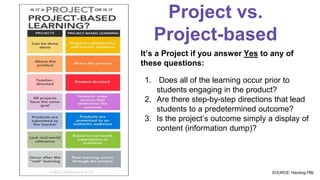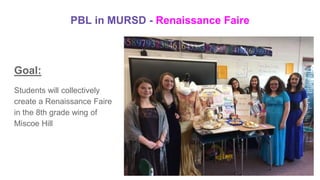Project-based learning
- 1. Project- Based Learning MURSD PD Day August 29, 2017 PBL
- 2. What is the essence of Project Based Learning? Source: Keys to PBL Series
- 3. Project-Based Learning: Defined“Students gain academic knowledge and develop critical thinking, collaboration, and other skills by investigating or responding to an open-ended question, problem, or challenge (often with real-world connections). They typically apply their understanding to create something new, teach others, or advocate for a solution.” Source: All Together Now. Suzie Boss.
- 4. Why PBL?
- 5. Why Project-Based Learning? “The ability to solve problems is more than just accumulating knowledge and rules; it is the development of flexible, cognitive strategies that help analyze unanticipated, ill-structured situations to produce meaningful solutions. Even though many of today's complex issues are within the realm of student understanding, the skills needed to tackle these problems are often missing from instruction.” (Reich, on the PBL webpage of California State University and San Diego State University).
- 6. What is the difference between project-based learning and a project?
- 7. It’s a Project if you answer Yes to any of these questions: 1. Does all of the learning occur prior to students engaging in the product? 2. Are there step-by-step directions that lead students to a predetermined outcome? 3. Is the project’s outcome simply a display of content (information dump)? Project vs. Project-based SOURCE: Hacking PBL
- 8. Grounded in the Real World SOURCE: https://dpalank.wordpress.com/2015/03/28/start-your-pbl-lesson-with-a- premortem-so-you-dont-need-a-post-mortem/ SOURCE: http://www.uft.org/editorial-cartoons/what-real-world-skills-do- you-have VS.
- 9. BIE’s Gold Standard PBL MODEL 1. Student Learning Goals a. Key Knowledge, Understandings, and Success Skills 2. Essential Project Design Elements a. Challenging Problem or Question b. Sustained inquiry c. Authenticity d. Student Voice/Choice e. Reflection f. Critique and Revision SOURCE: http://www.bie.org/
- 10. Design: Project-Based Learning TracksSet-Product Track Problem-Track Open-Ended Track Most Restrictive Medium Restrictive Least Restrictive Teacher identifies the set product the students must complete. Students can get to the end product through their own trial/error, but in the end the product was determined by the teacher Project is initiated by presenting students with a problem, or in some cases the students may identify the problem themselves. Project begins with the teacher sharing the standards and essential questions. Students then design a project that demonstrates their understanding. Example: Students learn about electricity and magnetism and force and motion through their work of creating a final product of a pinball machine. Example: Students consider how to tackle the dilemma of subpar cafeteria food, or to identify a problem important to their age group. Example: Students design a project that supports the understanding that an electric current can produce a magnetic field and a changing magnetic field can produce an electric current. SOURCE: Hacking PBL
- 11. Self-Reflection: Turning a presentation...into a presentation OF learning ● Can you share something you learned that we didn’t see in the final product? (New content knowledge gained) ● How did you make a difference for your team? (collaboration) ● What was your biggest obstacle? How did you overcome it? (redesign) ● What is the most important thing you learned during your work on this project? (key learning) ● What would they do differently if they had the opportunity to do the project again? (reflection) ● What would you change/add if you had more time? (growth)
- 12. PBL in MURSD Examples from WEx at Miscoe Hill: 1. Chinese Ingenuities Sales Pitch 2. Renaissance Faire Presented by: Jimmy Charest and Brendon
- 13. PBL in MURSD - Chinese Ingenuities Sales Pitch Goal: Effectively Market your Chinese Ingenuity to your peers. Process: Students… ● were assigned an achievement from the Ming dynasty ● conducted research about that achievement ● picked and wrote a RAFT about their achievement
- 14. PBL in MURSD - Chinese Ingenuities Sales Pitch RAFT (Role - Audience - Format - Topic) Options: ROLE (Who you are as the writer) AUDIENCE (Who you are writing to) FORMAT/GENRE (The format you are writing in) TOPIC (What you are writing about) Inventor/Salesman Investor Sales pitch To get people to fund your invention/product Inventor/Salesman Consumers Infomercial To get people to buy your invention/product Travel Agent Tourists Advertisement To get people to come see your achievement
- 15. PBL in MUrSD - Chinese Ingenuities Sales Pitch Sample: * Every video was different, and showcased the students’ individual personalities and research
- 16. PBL in MURSD - Renaissance Faire Goal: Students will collectively create a Renaissance Faire in the 8th grade wing of Miscoe Hill
- 17. PBL in MURSD - Renaissance Faire Process: Students… ● were grouped and then drafted a topic ● collaboratively researched and brainstormed ideas for the following: ○ Create a Website, Blog Topics and Entries, 3-D creative piece ○ A Video Advertisement, Costumes, Food ○ In-Class Presentation to Peers ○ Presentation Day of Faire to Parents/Community Members
- 18. PBL in MURSD - Renaissance Faire Examples Website 2Website 1
- 19. PBL in MURSD - Renaissance Faire Examples
- 20. PBL resources to explore http://mursdpd.weebly.com/project-based-learning.html
Editor's Notes
- they will watch the respective videos and take notes on the key phrases and essence of project-based learning elements?
- What would you identify from the videos you just watched as the key elements of PBL?
- Project Based Learning’s time has come. The experience of thousands of teachers across all grade levels and subject areas, backed by research, confirms that PBL is an effective and enjoyable way to learn - and develop deeper learning competencies required for success in college, career, and civic life. Why are so many educators across the United States and around the world interested in this teaching method? The answer is a combination of timeless reasons and recent developments. PBL makes school more engaging for students. Today’s students, more than ever, often find school to be boring and meaningless. In PBL, students are active, not passive; a project engages their hearts and minds, and provides real-world relevance for learning. PBL improves learning. After completing a project, students understand content more deeply, remember what they learn and retain it longer than is often the case with traditional instruction. Because of this, students who gain content knowledge with PBL are better able to apply what they know and can do to new situations. PBL builds success skills for college, career, and life. In the 21st century workplace and in college, success requires more than basic knowledge and skills. In a project, students learn how to take initiative and responsibility, build their confidence, solve problems, work in teams, communicate ideas, and manage themselves more effectively. PBL helps address standards. The Common Core and other present-day standards emphasize real-world application of knowledge and skills, and the development of success skills such as critical thinking/problem solving, collaboration, communication in a variety of media, and speaking and presentation skills. PBL is an effective way to meet these goals. PBL provides opportunities for students to use technology. Students are familiar with and enjoy using a variety of tech tools that are a perfect fit with PBL. With technology, teachers and students can not only find resources and information and create products, but also collaborate more effectively, and connect with experts, partners, and audiences around the world. PBL makes teaching more enjoyable and rewarding. Projects allow teachers to work more closely with active, engaged students doing high-quality, meaningful work, and in many cases to rediscover the joy of learning alongside their students. PBL connects students and schools with communities and the real world. Projects enable students to solve problems and address issues important to them, their communities, and the world. Students learn how to interact with adults and organizations, are exposed to workplaces and adult jobs, and can develop career interests. Parents and community members can be involved in projects. PBL promotes educational equity. All students deserve PBL, since a great project can have a powerful effect and help them reach their potential, and even be transformative for young people. A project that makes a real-world impact can give students a sense of agency and purpose; they see that they can make a difference in their community and the world beyond it.
- Give them a t-chart for them to complete….and then add to.
- Activity: Take a look at the project design elements with a partner….what do you think would be easy to implement? What might you find challenging? What do you need to learn more about? Student Learning Goals: Key Knowledge, Understanding, and Success Skills - The project is focused on student learning goals, including standards-based content and skills such as critical thinking/problem solving, communication, collaboration, and self-management. Important content standards, concepts, and in-depth understandings are fundamental to academic disciplines. In good projects, students learn how to apply knowledge to teh real world, and use it to solve problems, answer questions, and create high-quality products. Key Success Skills Key core competencies or success skills include critical thinking, problem solving, collaboration, and self-management. 2. Essential Project Design Elements Challenging Problem or Question - The project is framed by a meaningful problem to solve or a question to answer, at the appropriate level of challenge. Sustained Inquiry - Students engage in a rigorous, extended process of asking questions, finding resources, and applying information. It can mix traditional research with real-world, field-based interviews with experts and users. Authenticity - The project features real-world context, tasks and tools, quality standards, or impact – or speaks to students’ personal concerns, interests, and issues in their lives. Student Voice & Choice - Students make some decisions about the project, including how they work and what they create. Reflection - Students and teachers reflect on learning, the effectiveness of their inquiry and project activities, the quality of student work, obstacles and how to overcome them. Critique & Revision - Students give, receive, and use feedback to improve their process and products. Public Product - Students make their project work public by explaining, displaying and/or presenting it to people beyond the classroom.
- Let’s choose a standard and try to come up with ways that it would look in each of these tracks.
- This is an area where
- Rooted in the Standards: WHI.23 Summarize the major reasons for the continuity of Chinese civilization through the 19th century. (H) A. the role of kinship and Confucianism in maintaining order and hierarchy B. the political order established by the various dynasties that ruled China C. the role of civil servants/scholars in maintaining a stable political and economic order
- Rooted in the Standards: WHI.29 Describe the origins and development of the Renaissance, including the influence and accomplishments of Machiavelli, Michelangelo, Leonardo da Vinci, Raphael, Shakespeare, and Johannes Gutenberg. (H) WHI.30 Describe origins and effects of the Protestant Reformation. (H) A. the reasons for the growing discontent with the Catholic Church, including the main ideas of Martin Luther and John Calvin B. the spread of Protestantism across Europe, including the reasons and consequences of England’s break with the Catholic Church C. the weakening of a uniform Christian faith D. the consolidation of royal power WHI.33 Summarize how the Scientific Revolution and the scientific method led to new theories of the universe and describe the accomplishments of leading figures of the Scientific Revolution, including Bacon, Copernicus, Descartes, Galileo, Kepler, and Newton.




















